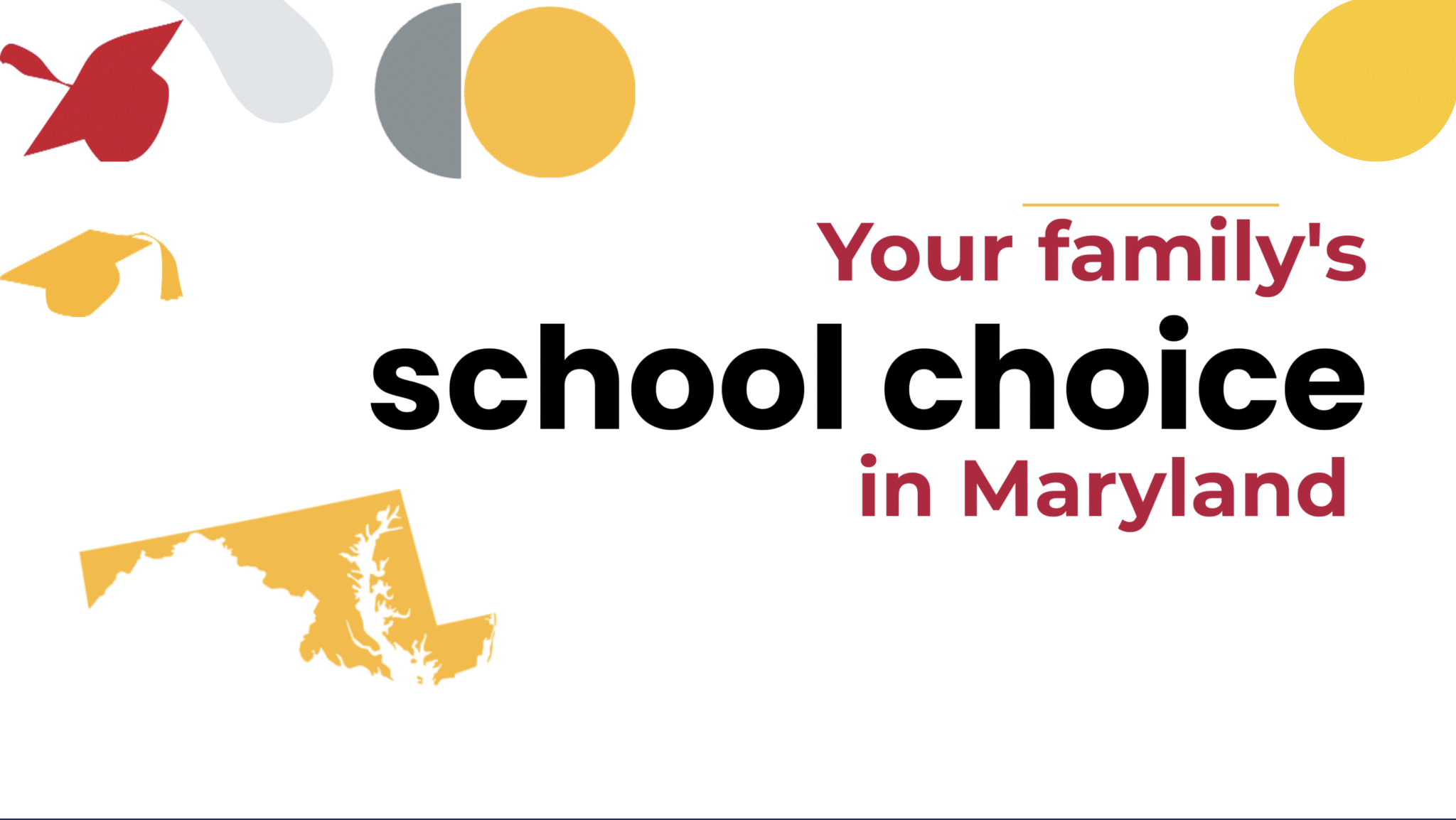Choosing a school? You’ve got options.
Each spring, parents face one of the biggest decisions they can make for their child’s future: What school environment will their child spend about 1,000 hours in next year? Sound familiar? Let’s dive in to school choice in Maryland.
Making that decision with confidence starts with knowing what options you have. You may have more school choices than you realize! Understanding these options can help you find a school where your child is excited to learn. Maryland families can choose from traditional public schools, public charter schools, public magnet schools, private schools, online learning, homeschooling, and microschooling and mix-and-match learning.
Looking for special education options? You can learn what special education services are available in Maryland at the Ultimate Guide to Special Education.

- Traditional Public Schools
- Public Charter Schools
- Public Magnet Schools
- Private Schools
- Online Schools
- Homeschool
- Microschooling
Maryland Traditional Public Schools
Most children (66% of all K-12 students) in Maryland attend traditional public schools. Traditional public schools are free to attend, open to all students, operated by school districts, and funded by taxpayers like you. Did you know Maryland spends an average of $16,417 per public school student each year? You can search your school’s spending and that of nearby schools at Project Nickel.
Most states have some form of open enrollment. This refers to whether parents can send their child to a public school other than their assigned school. Open enrollment is an important choice, expanding parents’ options and ensuring that zip code isn’t the sole determiner of their education. Unfortunately, Maryland only offers public open enrollment in a few circumstances. For example, a student may be able to request a school transfer if they move during the school year, if they are a child of an employee at the school they wish to transfer into, or if a health professional recommends a different school environment.
For a real-world example of the transfer process, check out the “Change of School Assignment Booklet” for Montgomery Public Schools, Maryland’s largest district.
Find out more about public schools in your state at the Maryland State Department of Education. You can learn more about Maryland open enrollment at “Public Schools Without Boundaries: A 50 State Report.”
Maryland Charter Schools
You can also choose charter schools. 2.4% of all K-12 students attend a public charter school in Maryland. Charter schools are tuition-free public schools that have extra freedom to innovate with curriculum and learning methods. Maryland has about 50 charter schools that parents can choose from.
Each school has a charter which explains the school’s purpose and what specific community need it serves. That could be providing a Spanish immersion program or offering a rigorous STEAM curriculum. If there are more families seeking admittance to a charter school than there are seats, a lottery system is usually used to determine admittance. In Maryland, charter school lotteries are usually held at the beginning of the calendar year.
Students with special needs who have an Individualized Education Program (IEP) are eligible to receive transportation assistance.
For more information on charter schools in your state, check out the Maryland Alliance of Public Charter Schools.
Maryland Magnet Schools
Magnet schools are free public schools that allow kids to narrow in on a specific learning track, such as an International Baccalaureate program or the performing arts. At a magnet school, all the subjects are taught through the lenses of that specific track. In Maryland, 16.4% of the K-12 student population attend a public magnet school.
Maryland has several magnet schools throughout the state; for instance, there are more than 30 magnet schools or programs in the Baltimore area. Some of the other districts with magnet schools include Anne Arundel County Public Schools, Washington County Public Schools, and Prince George’s County Public Schools.
For example, Deer Park Middle Magnet School offers eight creative magnet programs focusing on areas such as dance and mass communications. And recently, Anne Arundel County’s Old Mill Middle School South was named a National Magnet School of Excellence for its dedication to STEM learning and community partnerships.
If your child learns well through diving deeply into a particular subject, a magnet school could be a good fit.
Maryland Private Schools
As you may know, private schools are nonpublic schools that charge tuition. Maryland has a variety of private schools, both religious and non-religious: There are more than 800 private schools across the state.
Tuition varies widely, but the average in the state is $13,524 for elementary schools and $17,815 for high schools. Maryland has one private school choice program, the Broadening Options and Opportunities for Students Today (BOOST) Program, which provides state-run educational scholarships for families under a certain income level. More than 3,200 (0.3%) Maryland students took advantage of this program in the 2021-2022 school year.
Additional support may be available. For example, the Baltimore Educational Scholarship Trust partners with 18 private schools to provide admissions and financial support to high-achieving African American students in the Baltimore area. Also, the federal government allows parents to save for K-12 private school tuition using tax-preferred 529 savings accounts.
Learn more at Children’s Scholarship Fund-Baltimore, the Abell Foundation, Knott Scholarship Funds, Partners in Excellence, the Maryland Council for American Private Education, the Maryland Catholic Conference, and Private School Review: Maryland.
Maryland Online Learning
Online learning is sometimes overlooked, but it offers a uniquely flexible learning environment. For example, some families use this flexibility to accelerate learning. Meanwhile, others use it to provide a quieter, stress-free environment for learning. Whatever the reason, you may want to try online learning.
Unfortunately, Maryland does not currently have its own free, full-time online learning program available to students statewide. But, there are paid, full-time online school options available to families in all 50 states, Maryland included. Some of these paid providers are George Washington University Online High School, The Keystone School, Excel High School, and K12 Private Academy.
A local online option Maryland families can choose for a fee is Bryn Mawr Online, an AIMS-accredited, NCAA-approved, and AP-authorized online school for girls. The school is an outgrowth of Bryn Mawr School in Baltimore, which is ranked as the number one college prep school in Maryland.
Also worth mentioning is that students in select Maryland districts, like Baltimore City Public Schools and Montgomery County Public Schools, can access district-run online learning for free. In addition, the Eastern Shore of Maryland Blended Virtual Program offers a blended learning program to public school students in grades 6-12 in certain Maryland districts. These include: Caroline County, Cecil County, Dorchester County, Queen Anne’s County, Somerset County, Talbot County, Wicomico County and Worcester County public schools. Finally, students in some districts can take part-time courses through their school and Maryland Virtual Learning Opportunities.
To read more about online learning in Maryland, check out the Digital Learning Collaborative’s state profile.
Maryland Homeschooling
Also, Maryland families have a sixth option in homeschooling, which is the process of parents educating students at home. Homeschooling is permitted in all 50 states. If you are looking for a highly customizable and flexible education for your child and think homeschooling could fit the bill, learn more about Maryland’s homeschooling rules.
In Maryland, 2.8% of all K-12 students are homeschooled. Notice of your intent to homeschool is required immediately upon making this decision or your student will be considered truant. It is also required that you formally withdraw from your public school.
The state requires homeschooling parents to teach specific subjects (like math and English) and may also request to review samples of a homeschooling family’s education materials and work. In general, children who are homeschooled may face roadblocks if they want to participate in public school sports or activities in Maryland. But, you can always look for other leagues or activities near you!
Note that Maryland homeschool families are never required to enroll their children in public school. If you receive information to the contrary, you may want to ask for legal assistance. You can also check out the Maryland Homeschool Association and the Maryland Association of Christian Home Educators.
Maryland Microschools and Mix-and-Match Learning
Today, some Maryland families are mixing and matching school options to come up with new ways to personalize education. Microschools are one of these ways. A microschool refers to students gathering together in a small group – with adult supervision – to learn, explore, and socialize. Microschools can take a variety of shapes and legal forms, from homeschoolers coming together at an enrichment center to a private school committed to small classrooms. What microschools share in common is a commitment to small-group learning and close-knit relationships, along with an emphasis on children as individual learners.
Here are a couple of real examples of microschools in Maryland:
Montessori Luna is a bilingual Montessori school in Pikesville with a nature-inspired program.
Mysa Microschool in nearby Washington, D.C. offers place-based education with crowdsourced curriculum from around the world.
Remember, microschooling is more a mentality than a specific legal distinction in most cases. Often, a family participates in a microschool while legally homeschooling, or being enrolled in a private or online school.
Search for Schools Near Me
Microschooling and Mix-and-Match Learning
How can it empower parents and help kids achieve their dreams?
7 Step Guide
Tips to help you find a school where your daughter or son will learn, succeed, and be happy.
Education Resources for
Maryland Parents
For additional information about school choices in Maryland, visit these resources:
Every state is different when it comes to school choice options.
Sign up below to get a detailed comparison:
"*" indicates required fields
